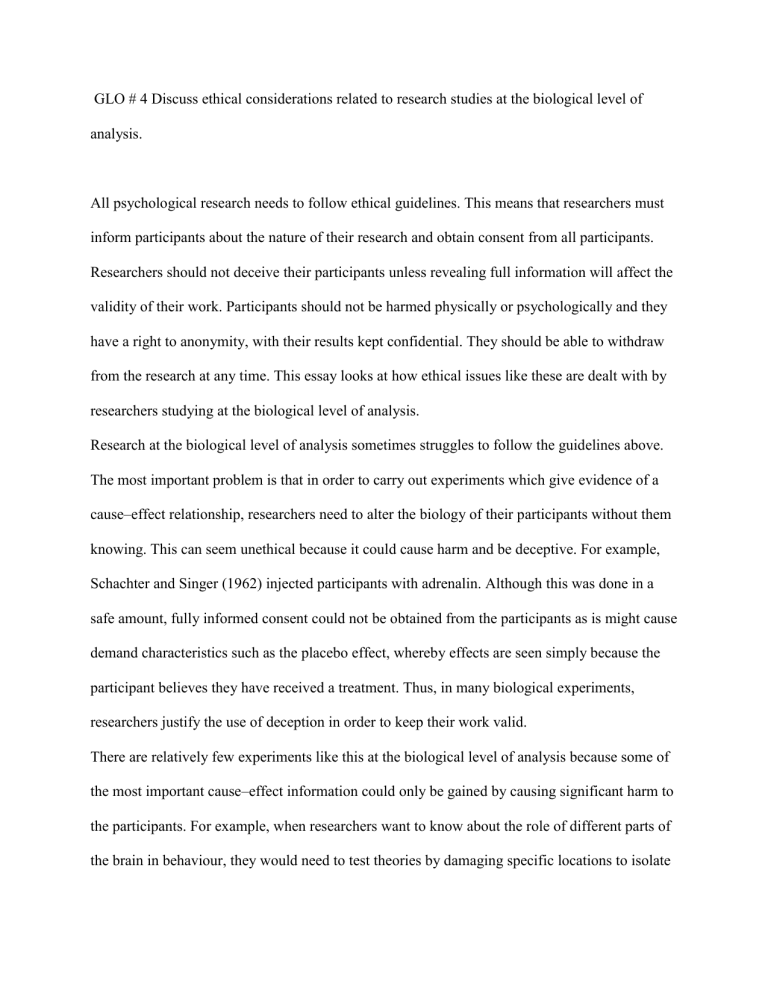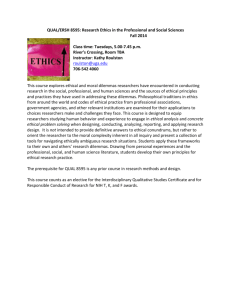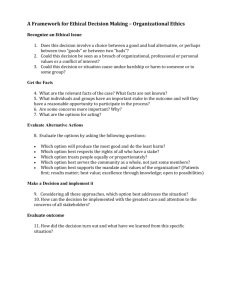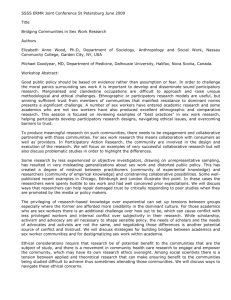BLOA #4 Sample Essay 2

GLO # 4 Discuss ethical considerations related to research studies at the biological level of analysis.
All psychological research needs to follow ethical guidelines. This means that researchers must inform participants about the nature of their research and obtain consent from all participants.
Researchers should not deceive their participants unless revealing full information will affect the validity of their work. Participants should not be harmed physically or psychologically and they have a right to anonymity, with their results kept confidential. They should be able to withdraw from the research at any time. This essay looks at how ethical issues like these are dealt with by researchers studying at the biological level of analysis.
Research at the biological level of analysis sometimes struggles to follow the guidelines above.
The most important problem is that in order to carry out experiments which give evidence of a cause–effect relationship, researchers need to alter the biology of their participants without them knowing. This can seem unethical because it could cause harm and be deceptive. For example,
Schachter and Singer (1962) injected participants with adrenalin. Although this was done in a safe amount, fully informed consent could not be obtained from the participants as is might cause demand characteristics such as the placebo effect, whereby effects are seen simply because the participant believes they have received a treatment. Thus, in many biological experiments, researchers justify the use of deception in order to keep their work valid.
There are relatively few experiments like this at the biological level of analysis because some of the most important cause–effect information could only be gained by causing significant harm to the participants. For example, when researchers want to know about the role of different parts of the brain in behaviour, they would need to test theories by damaging specific locations to isolate
causes and effects. Clearly it is impossible to do this, so researchers must rely on natural experiments and case studies, where the damage has already been caused and they can study possible effects. Examples of this include Sperry’s (1968) work with split-brain patients and
Ogden’s (2005) description of the case study of Janet.
In order to investigate the role of the corpus callosum in animals, it was possible to sever this link between the two hemispheres, but Sperry could not do this in humans. His work is a natural experiment because he carried it out with participants who already had their corpus callosum severed for medical reasons. Although this means that his work is ethical, it also means that his conclusions do not have as much validity as he did not manipulate the independent variable himself: this means that he could not confidently make cause–effect conclusions about the role of the corpus callosum in humans. Similarly, Ogden’s work with patients like Janet has revealed important information about the role of the right parietal lobe in causing hemi neglect, but case studies like that of Janet only involve the study of the effects with limited information about exactly how they are caused.
Medical professionals are able to ethically gather detail about damage, but again, cannot confidently make conclusions about cause. Modern brain-imaging technology has improved researchers ability to understand what has caused the damage, as in Janet’s case where a CT scan showed that she had a brain tumour. The famous case study of HM similarly is ethical in terms of not causing harm, and his initials were used to preserve anonymity, but there is some confusion about exactly what caused the memory problems that researchers studied in him. In particular, it is unclear whether his problems were caused by the damage done to his hippocampus during his brain surgery to correct epilepsy or if the drugs he took for many years afterwards might have also had a role.
Another group of studies that are ethical but have limited validity are quasi-experiments like
Maguire et al.’s (2000) study of London taxi drivers. MRI scans were carried out on drivers with a lot of experience driving in London and were compared with scans taken from the general population, looking at existing differences. A different, longitudinal experimental design is possible to study changes over time, but it would still not be possible to isolate the cause of differences between the brains of experienced drivers and inexperienced drivers without carrying out an unethical experiment.
The last group of studies to consider in terms of ethical issues is research involving animals. It is an obvious solution to the problems outlined above for researchers to harm animals instead of humans. Many people feel that all animal research is unethical because the animals cannot give informed consent, but it is generally accepted as long as the animals do not suffer too much and the research is of significant benefit to humanity. For example, Myers and Sperry (1953) severed the corpus callosum of cats to investigate its role in transferring information between the left and right hemispheres. This clearly did not result in unjustifiable suffering: it gave medical professionals the confidence to repeat the procedure with humans to correct epilepsy. It could be argued, however, that the manipulation of hormones in animals such as in Beach (1974) and
Young et al. (1964) causes the kind of changes to animals’ lives that will lead to future damage.
Beach’s female dogs exposed to male hormones were more likely to urinate like male dogs. If other behaviour was affected, this might prevent them living a natural life; in such cases, they may need to be euthanized.
Thus, there is a range of ethical issues that researchers working at the biological level of analysis must consider. Generally, ethical considerations prevent researchers doing the kind of
experimental work on humans that is necessary to confidently make cause–effect conclusions, and therefore they carry out their research using methods that do not cause damage to humans.




